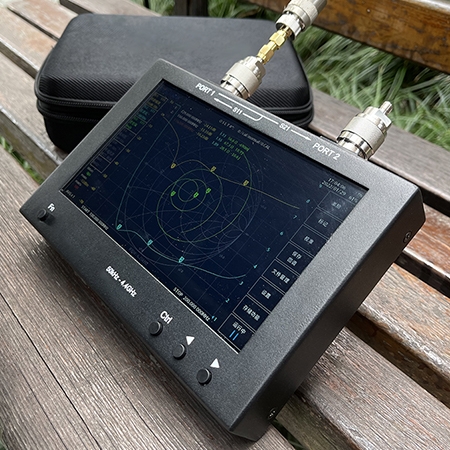The handheld VNA covers the MF/LF/HF/VHF/UHF frequency bands and can measure various antennas, as well as filters, amplifiers, attenuators, cables, duplexers, couplers, and more.

Wideband and High-performance, Professional and Portable
- Wideband and high-performance RF specifications: The VNA network core offers excellent RF performance, covering frequencies from 50kHz to 4.4GHz, meeting the testing requirements of most wireless communication bands. Its S21 dynamic range is up to 75dB (below 3GHz), and its S11 dynamic range is 50dB. Combined with a narrow IF bandwidth adjustable to 100Hz/30Hz, it ensures excellent measurement accuracy and sharp detection of small signals.
- Professional and Flexible Measurement and Analysis Capabilities: The handheld vector network analyzer offers fine resolution up to 1001 scan points and supports 7 traces (including TDR time domain reflectometry) and 8 markers, enabling simultaneous multi-parameter comparison and in-depth analysis. Built-in smoothing and 12 sets of calibration state storage significantly improve test efficiency and data reliability.
- Excellent Portability and Interactive Experience: The vector analyzer features a large, bright 7-inch IPS screen with dual operation modes, including capacitive touch and physical buttons. This provides a clear, intuitive, and smooth user experience, whether indoors or outdoors, truly leveraging the convenience of a handheld device.

A Professional Field Testing Tool
- Long-Lasting Battery Life and Convenient Power Supply: The VNA test equipment features dual built-in 18650 lithium batteries, providing up to 4 hours of battery life under typical use, meeting most field requirements. The universal USB Type-C port for charging and data transfer offers convenient recharging and modern connectivity.
- Massive Data Storage and Management: The vna network analyzer features a built-in 8GB memory card, easily storing large amounts of test data, screenshots, and instrument settings. This facilitates data archiving, subsequent analysis, and report generation without worrying about insufficient storage space.
- Rugged, Practical, and Fully Functional: The RF interface utilizes a standard N-type connector with an included adapter, ensuring durability and adaptability. It supports local one-click screenshots and boasts excellent power consumption (approximately 5W). Designed with the practical needs of field engineers in mind, it is a comprehensive professional tool.
Applications
The first is component research and development and characteristic analysis to help engineers optimize device design; the second is electronic product production quality inspection to quickly detect whether the product meets performance standards; the third is communication and RF system debugging to ensure the normal operation of the system; the fourth is aerospace to accurately test its RF performance in a wide frequency range and complex environment to meet stringent technical indicators.

Electronics

Communications

Aviation

Components
| Model | SISCO-VNA-SV4401A |
| Frequency Range | 50kHz~4.4GHz |
| RF Output Power | -42dBm~-12dBm, 1dB increments |
| RF Interface Type | N-type female, with N-to-SMA connector |
| RF Input Power | 0dBm (Max), DC < 5V |
| Frequency Accuracy | <±1ppm, <140MHz |
| <±5kHz, >140MHz | |
| S21 Dynamic Range | 75dB, <3GHz |
| 60dB, >3GHz | |
| S11 Dynamic Range | 50dB, <3GHz |
| 40dB, >3GHz | |
| Number of Sweep Points | 1001, adjustable from 1001 to 1001 |
| Sweep Speed | 400 points/second, f > 140MHz |
| IF Bandwidth | 12.5kHz (default), selectable: 6.25k/3.12k/300Hz/100Hz/ 30Hz |
| Smoothing | Arithmetic averaging, averaging coefficient 1-25x |
| Number of Traces | 7 |
| Number of Marker Points | 8 |
| Number of Calibration Status Memories | 12 groups, supports file storage on the internal storage card |
| Memory Capacity | Built-in 8GB memory card |
| Display | 7 high-brightness IPS LCD screens, 1024×600 resolution |
| Operation Method | physical buttons |
| Local Screenshot | Supports |
| Power Consumption | 5W charging |
| Battery Life | 4 hours (50% screen brightness) |
| Battery | Built-in 2 18650 lithium batteries |
| Charging/Data Port | USB Type-C |
| Charging Voltage | 4.7V~5.5V, 5V/2A charging recommended |
| Power Output | USB 5V/1A |
| Casing Material | Iron |
| Dimensions | 190mm×130mm×30mm, excluding RF port |
| Packaged Weight | 1.65kg |
Q1: How to use a vector network tester?
A1: First, ensure the instrument has been preheated and stabilized. Clean the connectors between the test port and the DUT and check that the connecting cables are intact. Next, enter the instrument's operation interface, set parameters such as the test frequency range, number of points, and power according to your test requirements, and select the appropriate test mode. Calibrate according to specifications. After calibration, correctly connect the DUT to the test port, start the test, and wait for the instrument to acquire data.
Q2: What types of vector network testers are there?
A2: Vector network testers are primarily categorized as benchtop, portable, modular, and specialized types integrated into semiconductor test systems. There are also specialized vector network testers for high-frequency bands such as millimeter-wave and terahertz, as well as variants with enhanced features such as time-domain analysis and multi-port expansion to meet the needs of different industries and applications.
Q3: What factors affect the test accuracy of a vector network tester?
A3: The test accuracy of a vector network tester is affected by a variety of factors, including the instrument's own systematic errors, calibration quality, test environment, DUT characteristics, the quality of test accessories and connectors, and the operator's professionalism. These factors combine to determine the accuracy and reliability of the final measurement results.
Tips: How Do You Calibrate a Vector Network Analyzer?
First, ensure the instrument and test environment are preheated and stable. Connect calibration components (such as open, short, load, and thru) to the test ports. Next, follow the instrument menu to select the calibration type (such as SOLT) and perform calibration for each port. The system will automatically measure and store the error model. Finally, verify the calibration results to ensure that the measurement accuracy meets the requirements. This process effectively eliminates systematic errors and ensures accurate and repeatable test data.
Thank you for buying industrial test and measurement equipment on SISCO.com, all products sold by SISCO and the partner cover a 12 months warranty, effective from the date of receiving the products.
What is covered?
SISCO is responsible for providing free spare parts, and free technical support to assist the customer to repair the defective products until the problem is solved.
What is not covered?
- Product purchased from anyone other than a SISCO store or a SISCO authorized reseller.
- Expendable parts.
- Routine cleaning or normal cosmetic and mechanical wear.
- Damage from misuse, abuse or neglect.
- Damage from use of parts other than SISCO approved.
- Damage from use outside the product’s usage or storage parameters.
- Damage from use of parts not sold by SISCO.
- Damage from modification or incorporation into other products.
- Damage from repair or replacement of warranted parts by a service provider other than a SISCO authorized service provider.
- Damage caused by the application environment not meeting the product usage requirements and the failure to perform preventive maintenance.

